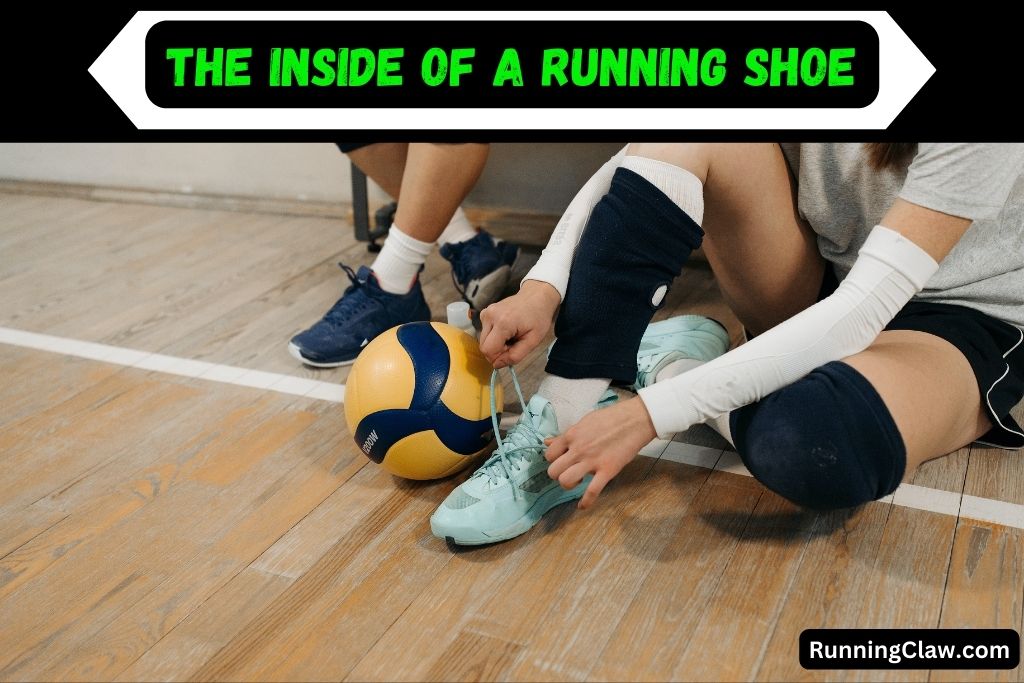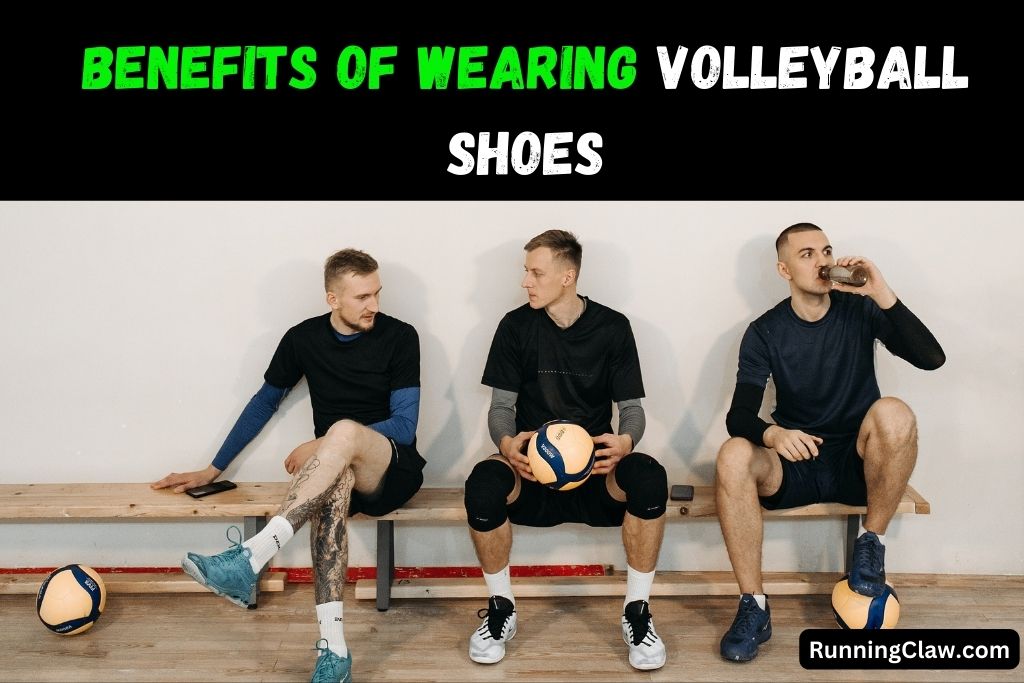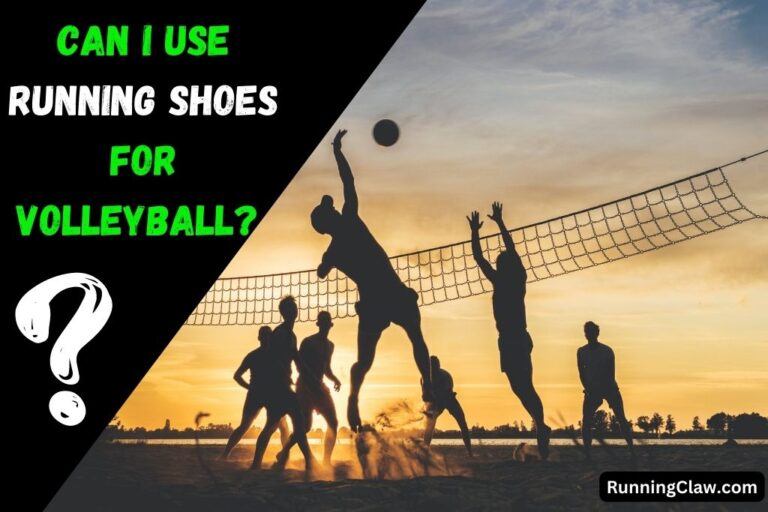Volleyball is another sport that requires good foot grip and great support from shoes. In volleyball, specific shoes are required, just like every sport has its own specific kind of shoe. But in every part of the world, the inflation rate is going up and up every day, and buying two different shoes for different sports might be difficult for most of us.
So you might be thinking of using your running shoes, which you use for your daily routine exercises and walks in parks. But can you really use running shoes for volleyball? This is something you must know about.
Let’s explore everything about volleyball shoes and using running shoes in volleyball.
Read | Can I Use Running Shoes for Lifting?
The Inside of a Running Shoe

Running shoes are created especially for runners, meeting their needs for support, cushioning, and flexibility in forward motion.
Let’s explore their distinctive qualities:
Materials:
To reduce weight and increase breathability, running shoes are typically made of lightweight materials like mesh, synthetic fabrics, and foam.
During long runs, this keeps the feet comfortable and cool.
Design:
Running shoes are made with a focus on providing seamless heel-to-toe transitions.
They frequently have a more substantial heel cushion and a more flexible forefoot to support the foot’s natural rolling motion while running.
Cushioning and Support:
Depending on what a runner needs, running shoes come with different levels of support and cushioning.
Neutral shoes offer basic support and are good for runners with normal arches. Stability shoes, on the other hand, are made for runners with mild overpronation and offer more support for the arch.
Motion control shoes help people who overpronate a lot by giving them the most support and stopping their feet from rolling in too much.
Read | Can I Use Running Shoes for Badminton?
The Inside of a Volleyball Shoe

Volleyball shoes, on the other hand, are especially designed to support the multidirectional movements, quick lateral cuts, and jumps that are distinctive to the sport.
Let’s focus on some of their distinctive qualities as well:
Material:
For comfort and breathability, mesh and lightweight synthetic materials are frequently used in volleyball shoes.
In order to guard against abrasions from sudden stops and court dives, they typically have a reinforced toe cap.
Design:
Volleyball shoes are made with an emphasis on lateral support, stability, and shock absorption for landing after jumps.
They have a wider base and a lower profile, giving players a stable base for quick movements on the court.
Lateral Support:
Volleyball shoes provide enhanced lateral support by including features such as external heel counters and rigid midfoot shanks. These features help to prevent ankle injuries and provide stability during side-to-side movements, which are essential when playing the sport.
Stability and shock absorption:
The midsole of a volleyball shoe is constructed with materials like EVA foam or polyurethane in order to provide stability as well as cushioning for the foot.
When jumping and landing, the responsive cushioning systems in the forefoot and heel of these shoes help to absorb impact and reduce the stress that is placed on the joints.
Traction:
In order to provide the best grip on indoor court surfaces, volleyball shoes have non-marking rubber outsoles with a herringbone or multi-directional pattern.
Fast direction changes and abrupt stops require this superior traction.
Read | Can I Use Running Shoes for Sports?
Is It OK to Use Running Shoes for Volleyball?

Running shoes are not suggested for volleyball. While volleyball shoes are made for lateral movement, running shoes are made for forward motion. Therefore, running shoes won’t offer the same level of stability and support that volleyball shoes do. Furthermore, the soles of running shoes are frequently thicker than those of volleyball shoes, which can make quick direction changes challenging.
The following are some justifications for why volleyball players shouldn’t wear running shoes:
- Lack of Lateral Support:
Running shoes are made to support movement in the forward direction, but they do not offer the same level of support for movement in the lateral direction. You may become more prone to ankle injuries as a result of this.
- Thick Sole:
A running shoe’s sole is frequently thicker than a volleyball shoe’s. It might be challenging to quickly change course as a result.
- Poor Traction:
Indoor surfaces are not intended for running shoes. You run a higher risk of slipping and falling if they don’t offer as much traction as volleyball shoes.
Purchasing a pair of volleyball shoes is crucial if you take volleyball seriously. The support and stability that you need to perform at your peak are provided by volleyball shoes.
Running Shoes vs. Volleyball Shoes

We can learn more about the similarities and differences between volleyball shoes and running shoes, as well as how these factors affect performance and injury risk, by comparing and contrasting these footwear types.
Similarities:
To ensure comfort while running or playing volleyball, both shoe types prioritize lightweight, breathable materials.
Cushioning systems are included to ease stress on the feet and joints.
Differences:
Design:
Volleyball shoes are built for lateral stability, multidirectional movements, and shock absorption during jumps, while running shoes are made for forward motion and smooth heel-to-toe transitions.
Volleyball shoes, which differ from running shoes in having a lower profile and wider base, provide a stable platform for swift court movements.
Impact on Performance:
Due to the lack of lateral support, stability, and traction designed specifically for volleyball courts, wearing running shoes may reduce performance.
This can impede quick movements and reduce overall court agility.
Functionality:
Running shoes vary in support and cushioning depending on the arch and pronation of the individual runner, whereas volleyball shoes emphasize lateral support and stability for all players.
Additionally, volleyball shoes have traction patterns that are specifically made for indoor court surfaces, while running shoes are made for different surfaces like roads and trails.
Risk of Injury:
In volleyball, especially when making sudden side-to-side movements, the lack of lateral support and stability in running shoes can increase the risk of ankle injuries.
Additionally, the cushioning systems in running shoes might not absorb enough shock during jumps and landings, putting more strain on joints.
Risk of Using Running Shoes in Volleyball

Let’s examine the dangers of playing volleyball while wearing a pair of running shoes because it’s crucial to comprehend any potential dangers connected to this decision.
Here, we go over some potential problems with wearing running shoes while playing volleyball:
Insufficient Support and Stability:
Volleyball shoes, unlike running shoes, require lateral support and stability features like external heel counters and rigid mid-foot shanks.
This can cause injuries to the ankle or other problems due to a lack of support, especially when making side-to-side movements.
Insufficient grip or traction:
Volleyball shoes are made with non-marking rubber outsoles and traction patterns that are made for the court. Running shoes don’t have these features.
So, they might not have the best grip needed for quick direction changes and sudden stops on indoor courts.
This can cause people to slip and fall, which makes it more likely that they will get hurt.
Reduced performance:
Since running shoes aren’t made for the specific needs of volleyball, they may hurt performance by not providing enough support, stability, or grip.
Players may find it hard to make quick moves, jumps, and landings, which can make them less agile on the court as a whole.
Benefits of Wearing Volleyball Shoes

Now I will be discussing some benefits of wearing appropriate volleyball shoes.
Better Traction:
The soles of volleyball shoes are typically made of a sticky rubber material that offers superior traction on the court. By doing so, you reduce the risk of slipping and falling, both of which can result in injuries.
Better Cushioning:
The midsole of volleyball shoes is typically thicker than that of running shoes, which results in increased cushioning for the wearer’s feet. Your joints will be better protected from injury as a result of this.
More Lateral Support:
When compared to running shoes, volleyball shoes feature a wider base, which results in increased lateral support. Injuries to the ankle are fairly common in volleyball, and this helps prevent those injuries.
Personal Experience:
Let me share you a story which is my personal experience regarding the usage of Running Shoes for Volleyball.
Once my Volleyb
all Shoes got damaged during an important match in my college days. I had no extra pair of Shoes with me except a pair of Running Shoes which I had to wear because there was no other option.
I played remaining match with Running Shoes and later I had to face consequences as well. I got an Injury in my Ankle which kept me out of the game for 3 months.
So I will never ever recommend you to wear Running Shoes for Volleyball.
Also Read:
Can I Use Running Shoes for Badminton?
Conclusion:
Volleyball shoes should prioritize safety, performance, and comfort.
Running shoes, though convenient, are not designed for volleyball and may increase injury risk and performance.
Cross-training shoes may be a better option, but they may lack volleyball-specific features.
Buying volleyball shoes is the best way to improve performance, support lateral movements, and prevent injuries.
You can improve your athletic performance and overall well-being by understanding volleyball shoes’ unique characteristics and using the tips provided to find the perfect fit.
Related Articles:
- How to Make Cleats Smell Better?
- What Sports Can Use Metal Cleats?
- Soccer Cleats Vs. Football Cleats
- Can Soccer Cleats Be Used for Football?
- Do Professional Soccer Players get Free Cleats?
- Can Soccer Cleats Be Used for Football?
- Do Puma Soccer Cleats Have A Warranty?
- What is The Difference Between Shoes and Cleats?
- Difference Between Soccer and Football Cleats


